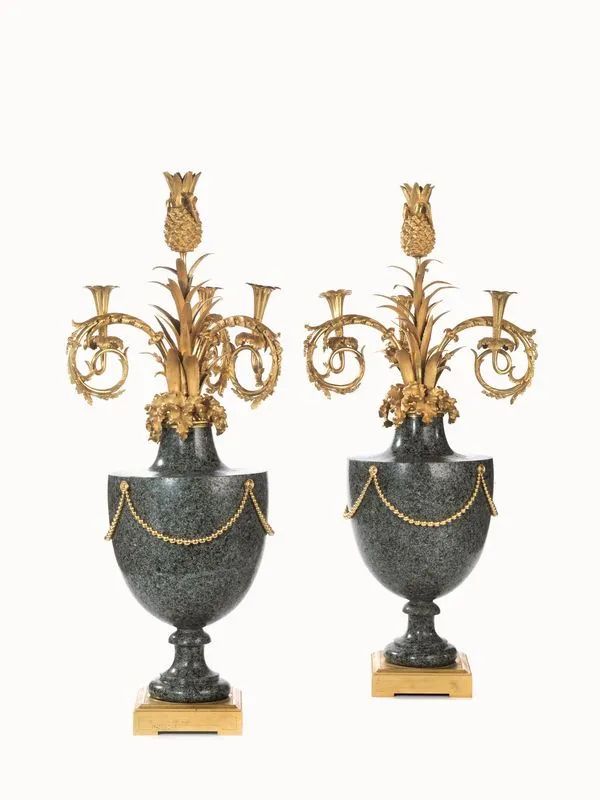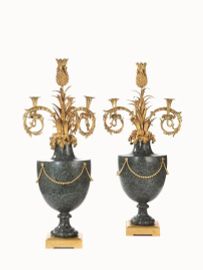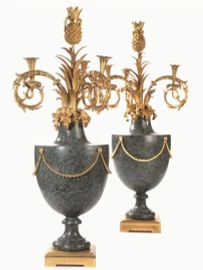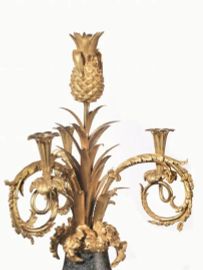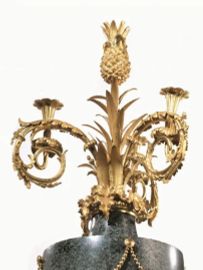A LOUIS XVI PAIR OF GIRANDOLES, FRANCE, CIRCA 1775
A LOUIS XVI PAIR OF GIRANDOLES, FRANCE, CIRCA 1775
Often produced as pairs so as to decorate, with their frilly folds, commodes and consoles as well as fireplaces and gaming tables, girandoles were extremely popular in the 18th century. What characterizes this particular type of candélabre is always a great sense of refinement: in the middle of a blaze of variously styled arms we find a central light that rises up as if it were a sudden firework, creating a wondrous play of effects that astonishes and entices the observer. While girandoles were historically made from a great variety of materials, including gold, silver, glass, and crystal, during the reign of Louis 16th gilded bronze became a favourite, often mounted upon bases made of porcelain or marbles such as porphyry and alabaster. Following this fashion, queen Marie-Antoinette commissioned Piton with the gilding of two copper putti which would adorn the girandoles for the Petit-Trianon; between 1782 and 1783 Remond delivered to the count of Artois a number of girandoles decorated with arabesques, “figure de nègre” and camels; finally, little chains, as well as leaf and pearl decorative motifs, enrich a pair of small three-arm girandoles mounted upon white porcelain vases supplied by Gallien in 1789 to Madame Élisabeth for her chateau in Montreuil.
Alongside pompous and elaborate decorations still reminiscent of rococo, the third quarter of the 18th century, under the reign of Louis XVI, saw the development of a new taste which privileged straighter and more clearly defined lines. Known as goût grec and inspired by the architecture of ancient Greece, the new style spread so rapidly that, by 1763, Baron de Grimm noted how “...tout est à Paris à la grecque”, everything in Paris was made in the new a-la-Greek style. It is against this background of stylistic transition that Jean-Claude-Thomas Chambellan-Duplessis carried out most of his work. He was born in Turin but was fully French in terms of formation, as well as being the son of Jean-Claude Duplessis, the sculptor, bronze-worker, and artistic director of the manufacture of Vincennes-Sèvres.
Founded in 1740 in the royal chateau of Vincennes and later moved to purposely built warehouses in Sevres, thanks to the support and protection of Louis XV and of Madame Pompadour, the manufacture managed to quickly attract the best French technicians, artists, sculptors and designers of the time. Duplessis senior was modelling director between 1748 and 1774, Jean-Jaques Bachelier was in charge of decorations between 1751 and 1793, Etienne-Maurice Falconet was responsible for the sculpting department between 1756 and 1766. These artists, together with the painter François Boucher, gave a fundamental contribution to making the manufacture the leader of the time in dictating the rules dominating French arts and crafts. The manufacture distinguished itself for its ability to constantly offer the most avant-gardist models and to always stay ahead of the evolution of its clientele’s taste. Under the guidance of Duplessis senior, the Sevres manufacture was among the first to be seduced by the forerunner style of French Neoclassicism and became its standard-bearer. It was under him that his son Jean-Claude-Thomas was formed; and in 1752 the latter began to assist his father in drafting models for the manufacture’s production.
After becoming maître fondeur en terre et sable in 1765, Duplessis specialized in creating various types of vases, authoring two series between 1775 and 1780. He became the reference point for the most illustrious French clientele, boasting prestigious clients such as Marie-Antoinette, for whom in 1775 he created the stand for a pair of vases which are today held in the Royal Collection in Buckingham Palace in London; or the Comtesse du Nord, Maria Feodorovna, for whom he created in 1782 the mounting for a toiletterie kit.
Among his most illustrious works, we may count four large neoclassical bronze candelabra, made around 1775 for the Fermier Général Laurent Grimod de La Reynière (1733-1793) and which went on to furnish the latter’s Paris residence, built in the same year.
Davillier, Julliot, and Paillet, in the catalogue for Le Cabinet du duc d'Aumont et les amateurs de son temps, remember the four girandoles as one of the best works by the artist, citing in support of their attribution to Duplessis the Almanach des Artistes from 1777: "Ces candélabres, dont le travail est très-soigné, ont été exécutés, lisons-nous dans un ouvrage du temps, par M. Duplessis, fameux Ciseleur de Paris, bon dessinateur qui travaille d'après ses dessins".
While two of these girandoles have already been identified as those sold at an auction at Christie’s in 2007 (fig. 1), the lot presented here – similar in everything to the former save for the colour of the granite, green instead of gray – could well complete the foursome commissioned by Laurent Grimod to decorate the palace designed for him by the architect Jean-Benoît-Vincent Barré, considered among the founders of the Louis XVI architectural style.
Further supporting the attribution of these two girandoles to Duplessis is the comparison with the pair of girandoles published by Kjellberg with an attribution to Duplessis (fig. 2), which bear almost identical motifs on the leaf-like arms centred by a large branch terminating in a pineapple, as well as an identical green granite base resting on a gilded-bronze square plinth; the lot we are offering here features fewer arms, and this fact, together with the rather sober pearled chain substituting the rich leafy decoration which runs down from the bights to the base, seems to bring the present artefact closer to a phase in which neoclassical taste was beginning to become more decidedly preeminent.
Comparative literature
J.-C. Davillier, P.-F. Julliot, A.-J. Paillet, Le Cabinet du duc d'Aumont et les amateurs de son temps : catalogue de sa vente avec les prix, les noms des acquéreurs et 32 planches d'après Gouthière, accompagné de notes et d'une notice sur Pierre Gouthière, sculpteur, ciseleur et doreur du Roi, et sur les principaux ciseleurs du temps de Louis XVI, par le baron Ch. Davillier, 1870;
P. Verlet, Les bronzes dorés français du XVIIIe siècle, Parigi 1987;
P. Kjellberg, Objets montés du Moyen-âge à nos jours, Parigi 2000;
G. Campbell, The Grove Encyclopedia of Decorative Arts, I, Oxford University Press 2006, p. 336

